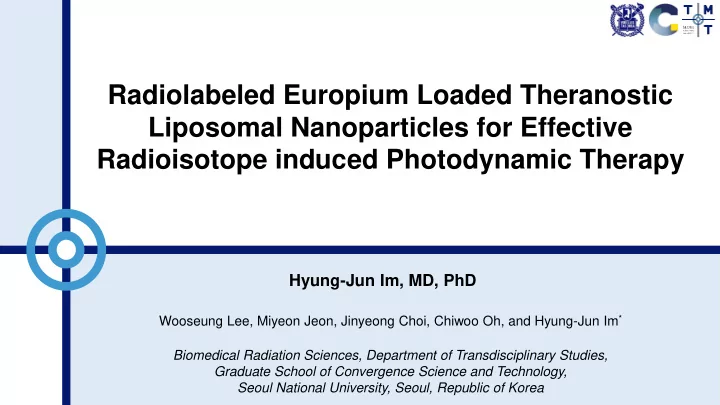

Radiolabeled Europium Loaded Theranostic Liposomal Nanoparticles for Effective Radioisotope induced Photodynamic Therapy Hyung-Jun Im, MD, PhD Wooseung Lee, Miyeon Jeon, Jinyeong Choi, Chiwoo Oh, and Hyung-Jun Im * Biomedical Radiation Sciences, Department of Transdisciplinary Studies, Graduate School of Convergence Science and Technology, Seoul National University, Seoul, Republic of Korea
What is Photodynamic Therapy? Introduction Anti-Cancer Therapy using Light Along with Photosensitizer (Triggering ROS) Advantages Limitations Curr. Pharm. Des., 2015 , 21(37), 5401-5416 Bioscience rep., 2015 , 35(6), e00265 Minimal invasiveness Repeatable therapy Less than 1 cm penetration depth Fewer adverse effects Lower cost Large tumor or deep tumor: ineffective treatment 2
To Overcome the Limitation of Conventional PDT Introduction X ray induced PDT Cerenkov luminescence induced PDT SAO:Eu J. Am. Chem. Soc., 2018 , 140(44), 14971-14979 Eu 2 O 3 NP Theranostics, 2016 , 6(13) , 2295 Strategy Strategy Particle radiation Cerenkov luminescence PDT X ray Radioluminescence PDT Advantage Advantage No additional X ray therapy Strong intensity of radioluminescence Longer time of light exposure Limitation Limitation Additional X ray therapy Relatively week intensity of Cerenkov luminescence NP with solid core: Limited biosafety NP with solid core: Limited biosafety 3
Eu / PS Loaded Theranostic Liposomal Nanoparticles for PDT Introduction Advantages Radioisotope, Eu and PS loaded Radioluminescence PDT No external light No additional X ray therapy Potentially higher efficiency than Cerenkov luminescence In vivo imaging Liposome based / Chelated Eu Europium (Eu) RL: Radioluminescence Biocompatible RET: RL energy transfer Victoria blue-BO (VBBO) ROS: Reactive oxygen species = Photosensitizer (PS) 4
Scheme of Synthesis Method 5
Characteristics of Eu / PS Loaded Theranostic Liposomal Nanoparticles Results Hydrodynamic size Stability tests in different physiological conditions ( λ ex= 640 nm) ( λ ex= 550 nm) ( λ ex= 615 nm) Day 0 Day 1 TEM images Day 7 6
ROS Generation Test and in vitro PDT Results ROS generation test In vitro PDT test 64 Cu-VBBO Lipo 18 *** 64 Cu-Eu/VBBO Lipo *** 16 Free 64 Cu 14 Increase ratio 12 10 *** 8 **** *** 6 *** **** 4 **** 2 0 0 30 100 200 64 Cu activity ( Ci) 7
Long Circulation and Efficient Passive Targeting Results In vivo PET imaging Blood pool (Heart) Blood pool (Heart) 8
Long Circulation and Efficient Passive Targeting Results Quantification at different time points Time activity curve in the blood pool y 0 : -0.0209 ± 3.7608 Fitting equation a: 38.4166 ± 3.5692 45 y = y 0 + a*e -bx b: 0.0331 ± 0.0063 R 2 : 0.9970 40 35 t 1/2 = 20.15 hours 30 %ID/g Blood pool ~ 20 %ID/g 25 Fit curve 20 15 10 5 0 10 20 30 40 50 Time (hour) 9
In vivo Radioisotope Induced PDT Results Normal saline 0 d 2 d 8 d 14 d Normal saline Eu/VBBO lipo 64 Cu-VBBO lipo 64 Cu-Eu/VBBO lipo Eu/VBBO lipo 64 Cu-VBBO lipo * ** * 64 Cu-Eu/VBBO lipo 10
Summary Conclusion 64 Cu-Eu/VBBO lipo : Eu / PS Loaded Theranostic Liposomal Nanoparticles for PDT Chelated Eu 3+ ion and photosensitizer (PS) loaded liposome by Self-assembly method Long blood pool circulation (t 1/2 = 20.15 hrs) and High passive targeting efficiency (~ 20 %ID/g) 64 Cu-Eu/VBBO lipo vs. 64 Cu-VBBO lipo RET showed higher efficiency than CLET Higher in vitro ROS generation and in vitro / in vivo PDT effects than 64 Cu-VBBO-lipo (based on CLET) 64 Cu-Eu/VBBO lipo could be a promising nanomedicine for a Novel Radioluminescence induced PDT using Radioisotope 11
Acknowledgements Department of Nuclear Medicine, Seoul National University Prof. Keon Wook Kang Prof. Hyung-Jun Im Prof. Gi Jeong Cheon Wooseung Lee Prof. Yun-Sang Lee Miyeon Jeon Chiwoo Oh Jinyeong Choi Gaeun Kim Seungki Baek
Thank you for your attention
Recommend
More recommend